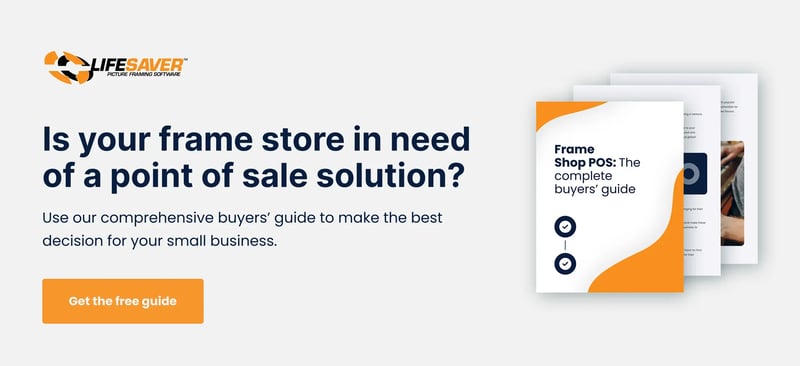
Quick sales and walk-ins can keep the lights on — but they won’t fuel long-term growth. If you want steady, predictable revenue, frame shop partnerships with designers and galleries are the way forward.
For these professionals, reliability is everything. They expect flawless communication, fast turnarounds, and consistent results — and with the right systems in place, you can deliver.
In this blog, you’ll learn six practical tips (and a few game-changing tools) to help you meet high standards, manage pressure like a pro, and build lasting frame shop partnerships.
1. Know Who’s Really Behind Your Biggest Orders
Not all customers contribute equally to your bottom line. Your most consistent and high-value orders often come from professionals who frame frequently and in bulk.
Focus on these high-value frame shop partnerships:
-
Work with interior designers: Frame sets that match their materials, timelines, and style preferences to help them create full-room installations.
-
Partner with art galleries: Prepare entire shows at once, using framing and mounting techniques that meet curatorial standards.
-
Collaborate with artists and photographers: Support their launches and exhibits by framing in batches, prepping pieces for sale, and offering gallery-ready finishes.
-
Serve corporate buyers: Handle large-scale framing for offices or hotels, often coordinating delivery and installation to meet project schedules.
Building relationships with these clients can lead to better profit margins and an established identity in the design or art community.
2. What Designers and Galleries Want From You
Designers and galleries juggle tight schedules and big expectations. They want a framer who gets it and delivers like a teammate, not a vendor.
To meet their expectations:
-
Show up like a professional: Meet deadlines, respond quickly, and track every work order detail — like mat choices, glazing, and mounting requests — to deliver exactly what was promised.
-
Offer trade pricing and flexible billing: Provide net 30 or 60 terms, offer discounted rates for industry partners, set up recurring invoices, and keep paperwork easy to process.
-
Handle short timelines without stress: Prioritize rush jobs, give status updates, and check craftsmanship carefully — even under pressure.
-
Make client handoffs straightforward: Coordinate pickup or delivery times, finalize specs early, and flag issues before they reach the customer.
Consistently meeting these expectations earns trust and opens the door to more high-value projects.
3. Understand Common Frame Shop Partnership Challenges and How To Handle Them
Even great clients get stressed when a project veers off course. With designers and gallery managers balancing a dozen moving parts, their pressure can quickly become your problem.
Here’s how to keep projects on track — even when the pressure’s on:
-
Set expectations before the project starts: Confirm specs, pricing, delivery dates, and responsibilities in writing to avoid confusion later.
-
Keep communication clear and consistent: Assign a single point of contact, recap all approvals, and log every change in your point of sale (POS) system to prevent details from falling through the cracks.
-
Handle changes without slowing progress: Include feedback checkpoints, flag delays early, and adjust the timeline as needed.
-
Protect quality under pressure: Use finishing checklists, verify high-value materials, and complete a final inspection.
Partnerships usually fall apart not because of bad framing but because of poor communication and missed follow-through. Stay reliable and proactive; you’ll earn long-term trust from the clients who count.
4. Maintain Beneficial Partnerships With Simple Habits
Some clients are worth rolling out the red carpet for. When a designer or gallery sends steady work your way, take the extra time and attention to make them feel like VIPs.
Encourage loyalty with gestures that show clients they’re respected and worth your time:
-
Check in regularly: Reach out between jobs to confirm satisfaction, ask about upcoming needs, and stay connected.
-
Hold space for loyal clients: Reserve time on your calendar to accommodate any last-minute requests from art store owners or interior designers who routinely use your services.
-
Offer exclusive perks: Give them trade discounts — like a set percentage off bulk orders or seasonal specials, faster turnaround windows, or first access to new framing options.
Little extras like these build loyalty over time — and keep your best clients coming back.
5. Turn Great Service Into Bigger Opportunities
In the custom framing world, word of mouth is one of the most effective ways to grow, bringing in up to 57% more new customers than other sources. When designers, galleries, or art buyers trust your work, they’ll likely refer collectors, curators, or other creatives who need the same level of expertise.
Here’s how to turn customer service excellence into new opportunities:
-
Incentivize with a referral program: Let regular clients know they can refer others and receive a credit toward future orders or a framed sample for their studio.
-
Host events that showcase your frames: Invite designers and galleries to an in-store evening where you feature their pieces, while showing off your craftsmanship.
-
Pitch joint promotions: Create gift cards for each other’s services, do social swaps, or collaborate on seasonal displays or giveaways.
Great work speaks for itself, especially in tight-knit circles like design and gallery networks, where reputation is your best marketing tool.
6. Use LifeSaver To Deliver Like a Pro
The right system makes it easier to meet standards, especially with trade clients and gallery partners. LifeSaver’s POS system gives you the tools to stay organized, responsive, and consistent across projects.
This all-in-one software lets you:
-
Organize every detail with work orders: Track specs, materials, approvals, and deadlines with templates that centralize everything in one place.
-
Manage complex projects with built-in messaging: Coordinate with your team and update clients in real time using internal notes and messaging tools.
-
Apply trade pricing automatically: Set up partner-specific discounts and payment terms.
-
Stay on track with visual project tools: Map timelines, preview designs, and track progress using production calendars and framing visualization software.
LifeSaver makes coordination easier, so you can focus on meeting deadlines and handling projects with the level of craftsmanship your partners expect.
Grow Your Frame Shop Partnerships With LifeSaver
Lasting frame shop partnerships depend on reliability, speed, and clear communication. They expect a frame shop to manage multipart orders, stay on budget, and deliver.
LifeSaver gives you the tools to make that happen. Work order tracking, visual production calendars, and partner-specific pricing features help you stay organized and responsive, no matter how fast the project moves.
Want to find the right POS system for your shop? Download Frame Shop POS Systems: The Complete Buyers’ Guide to compare features and discover how LifeSaver helps you build lasting client relationships for long-term success.

Aug 12, 2025 3:36:49 PM




